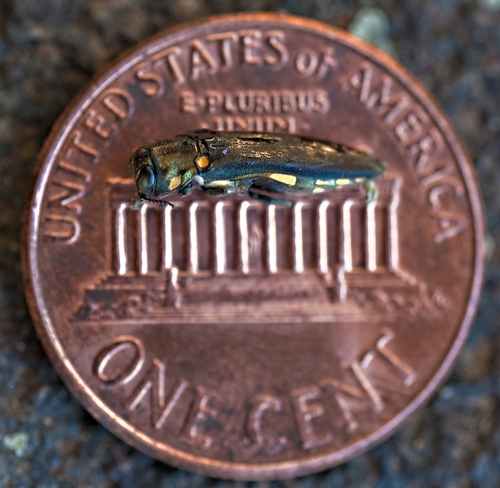First detected in San Diego County in 2004, the Goldspotted Oak Borer (GSOB) is contributing to oak mortality in southern California. GSOB larvae feed under the bark, damaging patches or strips of the phloem and cambium, the vascular tissues of the tree. The result is limb and branch dieback leading to tree death.
Records dating back to the late 1880’s show GSOB in Mexico, Guatemala and Arizona. While GSOB may have arrived in California from natural range expansion, it is quite possible this pest was introduced from firewood brought from Mexico.
Adults are about 10 mm long and 2 mm wide. They can be identified by six golden-yellow spots on their dark green forewings. Mature larvae are about 18 mm long and 3 mm wide. They are legless and white with a long, slender appearance and two pincher-like spines at the tip of the abdomen. Pupae are found in the outer bark and resemble adults, but are commonly white in color.
Damage from GSOB results in extensive bark staining, which can appear as black patches or red blistering with sap oozing from under the bark. This is caused by tunnels (galleries) constructed by the larvae primarily along the main stem from the base of the tree up to the larger branches. Larval tunnels are dark in color and have a meandering and generally vertical orientation. The 3 mm, D-shaped adult exit holes signify previous GSOB attack. On coast live oak (Quercus agrifolia), the bark is frequently removed by woodpeckers and reveals the deep red-colored outer bark that contrasts starkly with the gray exterior bark.
The presence of the larvae and their galleries, the emergence holes, and the associated woodpecker damage all distinguish GSOB infestation from infections with the pathogen that causes sudden oak death.
What can you do to help? Stay informed. California-specific management practices for GSOB are still in development. At this time it is recommended that people use management practices for other borer insects, although these practices have not yet been tested on GSOB in southern California. If GSOB is found on your property carefully follow instructions for removing infested materials. Most importantly do not transport infested firewood, and be mindful of where your wood comes from.
More information and photos can be found at UC Riverside's Center for Invasive Species Research.

Goldspotted oak borers are very small. Adults like
the one shown above are about 10mm long.